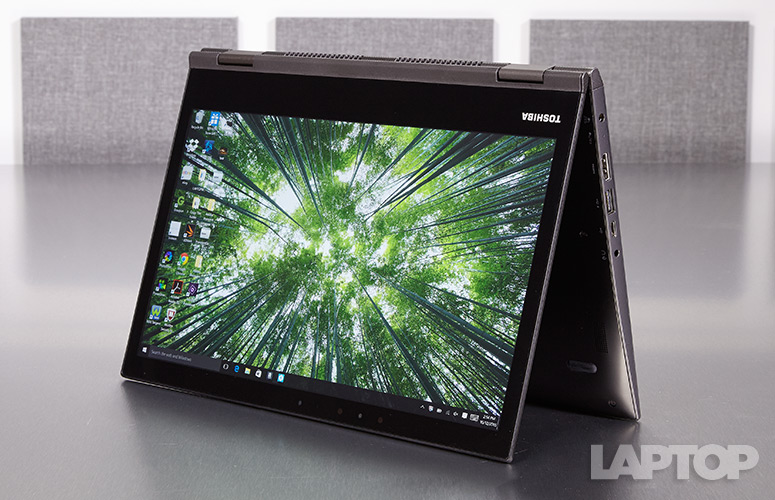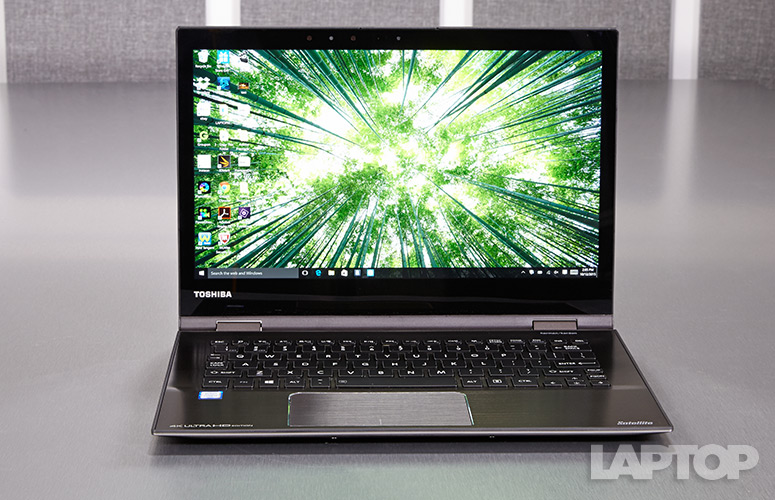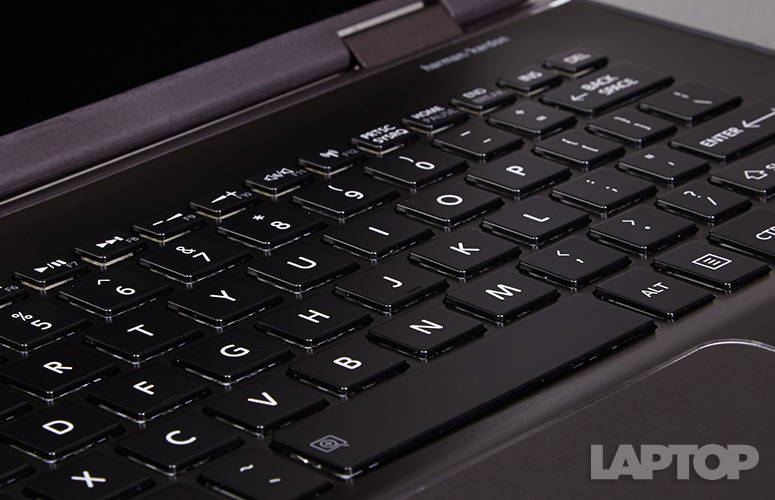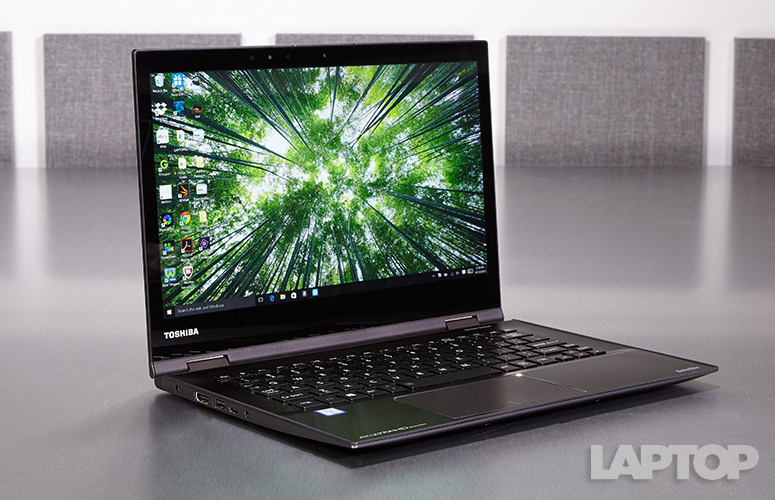Laptop Mag Verdict
A brilliant 4K display, a portable and attractive design, and above-average performance are spoiled by short battery life.
Pros
- +
Brilliant 4K display
- +
Attractive, compact design
- +
Good specs for the money
Cons
- -
Short battery life
- -
Touchpad is too far to the left
Why you can trust Laptop Mag
How many pixels can you cram into a notebook? Toshiba is testing the limits with the Satellite Radius 12, a 12-inch convertible with an optional 4K touch screen. But there's more to it than pixel count: This display, tailored to highly mobile photographers and video editors, is more colorful than any other display this size. Plus, this 3-pound hybrid comes with a 6th-gen Intel Core i7 processor, 8GB of RAM and a 256GB solid-state drive, all for $1,299. However, short battery life severely limits the laptop's value. Users who would trade pixels for performance should check out the 1080p Radius 12 ($800), which lasts longer on a single charge and did better in our tests.
Design
For a professional on the go, the Toshiba Satellite Radius 12 will fit comfortably into any briefcase, and will impress those around you when you show off its dark, brushed-metal finish. The 1080p Radius 12 has a very similar design that switches the black shell and deck for silver versions.
As with the rest of the Radius family, the screen on this 12-inch Toshiba can rotate 360 degrees, letting you also use it in tent, stand and tablet modes. The two hinges are much simpler than those on the Lenovo Yoga 900 -- no fancy 500-piece design here -- but they work just fine.
At 2.93 pounds, the Radius 12 is heavier than the Dell XPS 13 (2.8 pounds), the Lenovo Yoga 900 (2.8 pounds), the HP EliteBook Folio 1020 (2.68 pounds), the Dell XPS 12 (2.8 pounds) and the 12-inch MacBook with Retina display (2.03 pounds). Of course, none of those notebooks have displays that can bend back on themselves.
MORE: Best Toshiba Laptops
The 11.8 x 8.2 x 0.61-inch Radius 12 is larger than the 12-inch MacBook (11 x 7.7 x 0.14-0.52 inches) and the 12.5-inch XPS 12 (11.46 x 7.8 x 0.63-0.99 inches), roughly the same size as the XPS 13 (11.98 x 7.88 x 0.33-0.6 inches) and smaller than the HP EliteBook 1020 (12.2 x 8.27 x 0.62 inches) and the 13.3-inch Yoga 900 (12.75 x 8.86 x 0.59 inches).
Sign up to receive The Snapshot, a free special dispatch from Laptop Mag, in your inbox.
Display
There's no doubt that the 4K screen on the Radius 12 is one of the best I've seen on a laptop, and certainly on one this small. Everything on the screen just popped. Jared Leto's Joker was uncannily disturbing in a 4K trailer for Suicide Squad; I could see every pore and scar, and his metal teeth glistened. Similarly, I could see every raindrop and scratch on Batman's armor in Batman v Superman: Dawn of Justice.
Photos, too, were more vivid than I've seen on most other notebooks. The contrast in images of Gotham Hall brought out the ceiling details clearly, and the blacks and blues in the lighting and shadows were rich. In another shot of a BMW, I could easily make out the subtle reflections in its white door panels.
Despite the screen's Lilliputian size of 12.5 inches, Toshiba packed in 4K (3840 x 2160) resolution, making everything crisp and clear. It's leagues higher than the HP EliteBook 1020 (12.5 inches, 2560 x 1440), the MacBook (12 inches, 2304 x 1440), the MacBook Pro (13 inches, 2560 x 1600), the Dell XPS 12 (12.5 inches, 1920 x 1080), the Yoga 900 (13.3 inches, 3200 x 1800) and the Dell XPS 13 (13.1 inches, 3200 x 1800).
Over on the 1080p Radius 12, the colors in the 1080p trailer for Suicide Squad looked too warm, with Margot Robbie's hair appearing slightly yellow, and Jared Leto's skin not appearing as white as it should be. Of course, we also missed the depth of detail seen on the notebook's 4K counterpart. Still, for most tasks, a resolution of 1080p will be just fine.
MORE: Best 2-in-1s (Laptop/Tablet Hybrids)
Not only is the display sharper than those on similarly sized competitors, but Toshiba says its panel is capable of producing up to 100 percent of the Adobe RGB color gamut, far higher than on a typical laptop. Toshiba's claims were accurate; we measured an Adobe RGB score of 99.8 percent. Typically, we only measure for the sRGB standard -- a much smaller range of colors -- and on that, the Radius 12 also hit 99.9 percent. On this sRGB test, the Radius 12 topped the Dell XPS 13 (96.6 percent), the Yoga 900 (93.2 percent) and the HP EliteBook (95.3 percent) but fell slightly below the MacBook's 101.3 percent and the 1080p Radius 12 (105.2 percent). The Dell XPS 12's screen topped all of its competitors in this measurement, displaying 114.3 percent of the spectrum.
The Radius 12 also gets top marks for color accuracy. Its score of 0.59 on our Delta-E test (numbers closer to 0 are better) beats the Yoga 900 (2.77), the XPS 12 (4.39), the XPS 13 (5.1) and the Folio (7.4) by a wide margin, and even the MacBook (1.2). If you opt for the 1080p Radius 12, expect less accurate color, as it earned a Delta-E score of only 2.79.
With an average brightness of 338 nits as measured by our light meter, the 4K Radius 12 outshone the XPS 13 (295 nits), the Yoga 900 (284 nits) and the EliteBook (224 nits), and came up just short of the 12-inch MacBook (353 nits) and the 1080p Radius 12 (369 nits). With 413 nits of brightness, the Dell XPS 12 is brighter than all five of those notebooks.
Audio
Two downward-facing speakers on the Radius produced good, but not great, sound. Walk the Moon's "Shut Up and Dance" had a tinny, harsh quality with little bass. The sound improved a bit when I flipped the notebook into tablet mode; the music was able to reflect off the bottom of the Radius 12, which made everything sound more resonant.
Keyboard
For such a thin notebook, Toshiba did a pretty good job of putting in a keyboard that maximizes its space. It's not my favorite laptop keyboard, as its travel of 1.35 millimeters is a bit less than you'll find on a typical notebook (around 1.5 mm).
I also wish that the keys were slightly concave and that the arrow buttons were larger. I found myself making more mistakes than I would on my usual desktop keyboard. Still, I had little trouble writing this review, and appreciated the backlight, even if it offered only one level of brightness.
One nice Windows 10 touch Toshiba added to all of its notebooks is that it made the F1 key a Cortana button; pressing it opens Microsoft's new voice assistant.
MORE: The Best Laptops for Every Need
I wish that the 4.25 x 2.2-inch touchpad were centered under the G and H keys; it's slightly to the left, so the left palm rest is a bit undersized. Even after adjusting the palm rejection in the Control Panel, I found that my palm would occasionally brush against the touchpad, causing the cursor to jump.
Ports and Webcam
The left side of the Radius 12 has a full-size HDMI port, a USB 3.0 port and a USB 3.1 Type-C port. The right side has one more USB 3.0 port, an SD card slot, a power button, a volume toggle and, in another thoughtful addition, a Cortana button, for when you're using the Radius 12 in tablet mode. The button was stiff enough so that you can't inadvertently activate it.
Performance
With a 6th-generation Intel 2.5-GHz Core i7-6500U processor, 8GB of RAM and a 256GB SSD, the 4K configuration of the Radius 12 was adept at everything I threw at it. The 1080p Radius 12 we tested had a 2.3-GHz Core i5-6200U processor, 8GB of RAM and a 256GB SSD, and managed to notch better scores than its more expensive and pixel-rich sibling, despite having a slightly slower processor. The lower-resolution model likely scored better, because it had to push fewer pixels.
On Geekbench, the 4K Radius 12 scored 5,779, while its 1080p sibling notched an even stronger 6,258. That's better than the category average (4,340), as well as the Core M-powered Dell XPS 12 (4,875), the HP EliteBook 1020 (3,814) and the Apple MacBook (4,631), and slightly higher than the Core i5-powered XPS 13 (5,653). However, the MacBook Pro's Core i5 processor and flash memory hit a much higher 7,113, and the Core i7-6500U-powered Yoga 900 earned a 6,264.
The 4K Radius 12 took 19.7 seconds to open a 69MB Word document in OpenOffice. While that's a second slower than the XPS 13 (18.7 seconds) and the MacBook Pro (13.4 seconds), the Toshiba redeemed itself when we ran the same test, only this time with our file copy test running in the background. The Radius 12 took 27.3 seconds, making it nearly 9 seconds faster than the XPS 13 (36.5 seconds).
MORE: The Best Laptops for Business and Productivity
On our Spreadsheet test, the 4K Radius 12 took 5 minutes and 34 seconds to pair 20,000 names and addresses in OpenOffice. The EliteBook took more than a minute longer (6:36), while the XPS had the same time as the Toshiba. The XPS 12 (5:13), the MacBook (4:33), the Yoga 900 (4:18) and the 1080p Radius 12 (4:29), however, finished the test in shorter times.
Graphics
While the 4K Radius 12 has only integrated Intel 520 graphics, that should suffice for small video- and photo-editing work while you're on the road. Using Adobe Premiere Elements, it was able to downscale a 205MB, 1080p video to 720p in 1 minute and 41 seconds. That's a few seconds slower than the XPS 13 (1:34; Intel HD Graphics 5500) but much faster than a 13-inch MacBook Pro (early 2015) -- which has Intel Iris 6100 Graphics -- and took 3 minutes and 14 seconds.
However, look elsewhere if you're planning to game on this notebook. On our World of Warcraft test, the closest the 4K Radius 12 came to a playable frame rate (30 fps) was with the resolution at 1366 x 768 and the graphics set to Good. Even then, it managed only 27 fps. Still, that's no worse than competing systems.
At a resolution of 1280 x 800, the MacBook notched 27 fps, and the MacBook Pro hit 43 fps at the same settings. The XPS 13 hit 35 fps at 1080p while set to Good.
On 3DMark Fire Strike, the 4K Radius 12's score of 841 bested that of the XPS 13 (740), and was more than double that of the EliteBook (403). The 1080p Radius (798) fared worse than the 4K version in this test, but still beat both of those competitors.
Battery Life
Understandably, notebooks with 4K displays use considerably more power than those with lower-resolution panels. We saw this with the Dell XPS 13 -- an XPS model with a 1080p display lasted 11 hours and 42 minutes, whereas a version with a quad-HD display lasted 7 hours and 24 minutes.
But even by those standards, the 4K Radius 12 falls well short. Although Toshiba says the notebook should last up to 6.5 hours, on the Laptop Mag Battery Test (Web surfing via Wi-Fi), the 4K Radius 12 lasted a mere 5 hours and 17 minutes. That's just as short as the time recorded by the Dell XPS 12 (5:17), and more than 3 hours less than the ultraportable average (8:02).
MORE: Laptops with the Longest Battery Life
The 1080p version of the Radius 12 lasted a longer, but still below-average 7 hours and 22 minutes, which makes sense, given that it has fewer pixels to illuminate. The HP EliteBook Folio (which has a quad-HD display) lasted 6:49, the Yoga 900 (which has a quad-HD+ display) lasted 7:57 and the 12-inch MacBook lasted 8:43. The 13-inch MacBook Pro with Retina display lasted an excellent 12:04.
Configurations
We tested two configurations of the Radius 12, one with a 4K display and one with a 1080p screen. The 4K model is the high-end configuration of the Radius 12, which costs $1,299 and comes with a 2.5-GHz Intel Core i7-6500U processor, 8GB of RAM and a 256GB SSD.
The 1080p model costs $800 and comes with a Core i5-6200U processor, 8GB of RAM and a 256GB SSD.
Software
Toshiba keeps the software load pretty light on the Radius 12. The usual suite of Toshiba utilities (such as the power-saving Eco utility and a media player) are included, but the company also added a few apps to take advantage of the notebook's 4K display.
Chroma Tune lets you change the color profile of the display to one of the following settings: Technicolor, Cool, Warm, Rec. 709, Adobe RGB or Native. You can also configure the utility to automatically change profiles depending on which app you're using -- for instance, Adobe RGB with Photoshop, and Technicolor with Premiere. I just wish you could create your own profile.
Bottom Line
There's no doubt that Toshiba packed a lot into a little package with the Radius 12. The 4K version of the laptop has an amazing display and great performance, and it packs all that into a convertible weighing just less than 3 pounds. The 1080p Radius 12 may not feature as brilliant a screen, but its added battery life makes it more useful for anyone spending time away from a desk.
Though we like its screen a lot, we can't recommend the 4K version of the Radius 12, because of its awful battery life. The 1080p configuration is definitely worth considering, because of its lower price, stronger performance and much better endurance. If you don't need a 2-in-1, you can get much longer endurance with the 12-inch MacBook. Among 2-in-1s, the Dell XPS 12 has lower endurance but offers a better keyboard and a stylus. However, if you want a solid, bend- back 2-in-1 at a competitive price, the base model of the Satellite Radius 12 is a solid choice. If you can spend a little more, the Yoga 900 offers faster performance and much longer battery life with a screen that's almost as sharp and colorful as the panel on the 4K version of the Radius.
Toshiba Satellite Radius 12 Specs
| Brand | Toshiba |
| CPU | 2.5-GHz Intel Core i7-6500U |
| Card Slots | 2-1 card reader |
| Company Website | www.toshiba.com |
| Display Size | 12.5 |
| Graphics Card | Intel HD 520 graphics |
| Hard Drive Size | 256GB |
| Hard Drive Speed | n/a |
| Hard Drive Type | SSD Drive |
| Native Resolution | 3840 x 2160 |
| Operating System | Windows 10 |
| Ports (excluding USB) | USB-C, HDMI, Headphone/Mic, USB 3.0 |
| RAM | 8GB |
| RAM Upgradable to | AddNewOpt |
| Size | 11.8 x 8.2 x 0.61 inches |
| Touchpad Size | 4.3 x 2.1 inches |
| USB Ports | 3 |
| Video Memory | Shared |
| Weight | 2.9 pounds |
| Wi-Fi | 802.11ac |
| Wi-Fi Model | Intel Dual-Band Wireless AC 7265 |
Michael was the Reviews Editor at Laptop Mag. During his tenure at Laptop Mag, Michael reviewed some of the best laptops at the time, including notebooks from brands like Acer, Apple, Dell, Lenovo, and Asus. He wrote in-depth, hands-on guides about laptops that defined the world of tech, but he also stepped outside of the laptop world to talk about phones and wearables. He is now the U.S. Editor-in-Chief at our sister site Tom's Guide, where he oversees all evergreen content and the Homes, Smart Home, and Fitness/Wearables categories for the site..






